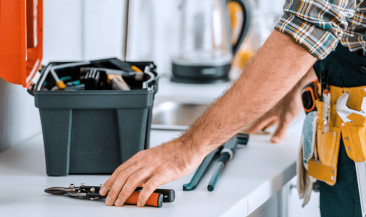
Real estate management involves managing real property. This applies to both commercial and residential real estate properties. It also includes employees, equipment, and physical capital assets.
Property management is an extremely complex business. The first thing a property manager should do is to get to know the local rental market. They also need to be able understand the tenants' needs. They may have responsibilities in the areas of marketing, maintenance, and conflict resolution. They will also need to be familiarized and able to apply federal statutes to their business.
Professional companies offer property management services. Many states require property manager licenses. These property managers are usually licensed salespeople or realtors. Other professionals involved in this field include investors, developers, bankers and appraisers.
A typical property management service includes cost budgeting, tenant placement, advertising and marketing. They can provide financials and advice on tax deductions as well as long-term planning strategies. These companies often deliver financials on an annual or quarterly basis.

A professional property management company will save you both time and money. These companies are able to manage multiple properties simultaneously and can provide assistance for tenants. Moreover, they can provide quick responses to tenant inquiries. They also provide repair services.
When working with a real estate management firm, you will have to pay a management fee. This is typically 8% to 10% of the rental amount. The fee is not required until you have signed a contract. Some companies also charge a set-up fee and a fee for letting tenancy.
Property managers, unlike traditional landlords will keep an eye on repairs and maintenance. They are also able to recommend marketing strategies. They can help you increase your profits all year.
One of the biggest drivers for property managers is the influx of tenant maintenance calls. Landlords who own their rental properties are often overwhelmed by tenant maintenance calls. This is why it's so important to get a qualified property manger.
Property managers are well versed in the industry and are able to handle multiple properties at once. They can also keep detailed accounting reports. Moreover, they can provide owners with reports online.

Property management is an investment. So it's important that you choose a company which will give you good value for your dollar. A great property management firm will ensure that your tenants have a less stressful experience.
Property managers should be well-versed in laws, regulations and other rules that regulate rental properties. They must be able evict tenants without notice if the tenant is not paying and to collect late payments. A contractor's policy is required. They must be able adhere to the lease's terms.
Property management can be a good option for landlords who do not live nearby their rental properties. It can be time-consuming. A property management company is a good investment if you are having problems with rent payments or tenant problems.
FAQ
Are there any things I should be aware of before I hire a handyman to help me?
Hire someone with experience in the type of project you are looking for. You should also check references and ask past customers. You may also want to include some extra money to cover unexpected expenses. Also, you'll want to make sure he's insured and licensed.
What qualifications do I need to be a handyman?
You will need patience to be a handyman. Also, experience with working with electrical systems, carpentry skills and plumbing knowledge is essential.
It is likely that you will find many jobs for people who have the right qualifications. But if you don’t, you may not be qualified.
You might want to consider getting training from a school specializing in these courses.
What is the hourly rate for a handyman?
An hourly rate for a handyman is between $50 and $75. Many have been doing this job for many years. Their average time on any job is approximately 10 hours. They are well-known in their community and don't have to advertise.
They will tend to specialize and establish customer relationships over time.
They are quick, reliable, and affordable. This is the key difference between them and other contractors.
Most people know at least 2-3 of these guys they trust enough to call when they need help.
Some people are so talented that they own their own business.
Statistics
- According to the U.S. Bureau of Labor Statistics, in May 2020, there are 1,357,630 handymen employed in the U.S.. (angi.com)
- “Before the pandemic, 40% of people asked how we could estimate a job when we weren't there,” Rose recalled. (inquirer.com)
- “Once the pandemic hit, that number fell to about 20%.” (inquirer.com)
- More than 20% of homes in America have outdoor living spaces, including decks and patios. (mrhandyman.com)
- Another estimate was that the market in the United States was $126 billion and was increasing by about 4% annually. (en.wikipedia.org)
External Links
How To
How to Replace a Broken Tile
Step 1: Remove the old tiles.
The tiles should be removed from the flooring and placed aside. If you plan to use these tiles later, it is important that you keep them in good condition. You can note the parts that are missing or damaged so that you can find replacements.
Step 2 -- Choose New Tiles
Look at these different options for replacing tiles.
-
You can find a tile replacement that is similar to the one you have just removed.
-
To find the matching piece, use the measurements that you took while removing the tile. This will make it much easier to find the right size without measuring again.
-
Look for various colors, patterns, textures, sizes, shapes, etc.
-
Consider which grout you would like to use, if any. Some prefer a solid color, while others like mixing it up.
-
Make sure the tile you select is resistant to moisture.
-
Finally, consider the placement of your new tile -- you can save time and money by ensuring the area you're installing it in has enough space for proper installation.
-
Once you've picked your tile, place an order online or call your local Lowe's location to place it.
Step 3 - Place the tiles.
Use the same method as before to install your new tiles. It is important to align them correctly so they fit together properly.
Step 4 - Clean up
Be sure to vacuum up all crumbs and debris before applying the last layer.
This will stop dirt and dust from entering the cracks between tiles.
Step 5 - Sand the Floor
After everything has been cleaned, sand it down to remove any remaining particles from the previous steps.
Step 6: Finish off
Apply the protective coatings once the floor is smooth. Wait until the floor is completely smooth before applying the protective coatings to the tiles. Wet paint could stain the tiles' surface.
To protect your floors from stains, you can use "damp-and dry" products.
But it won't address every issue that might arise after installing your new tiles. You might want to add an anti-slip coating to the protective layer if there are a lot of children.
Last but not least, be sure to leave the protective sealing on for several weeks before you return to your home.